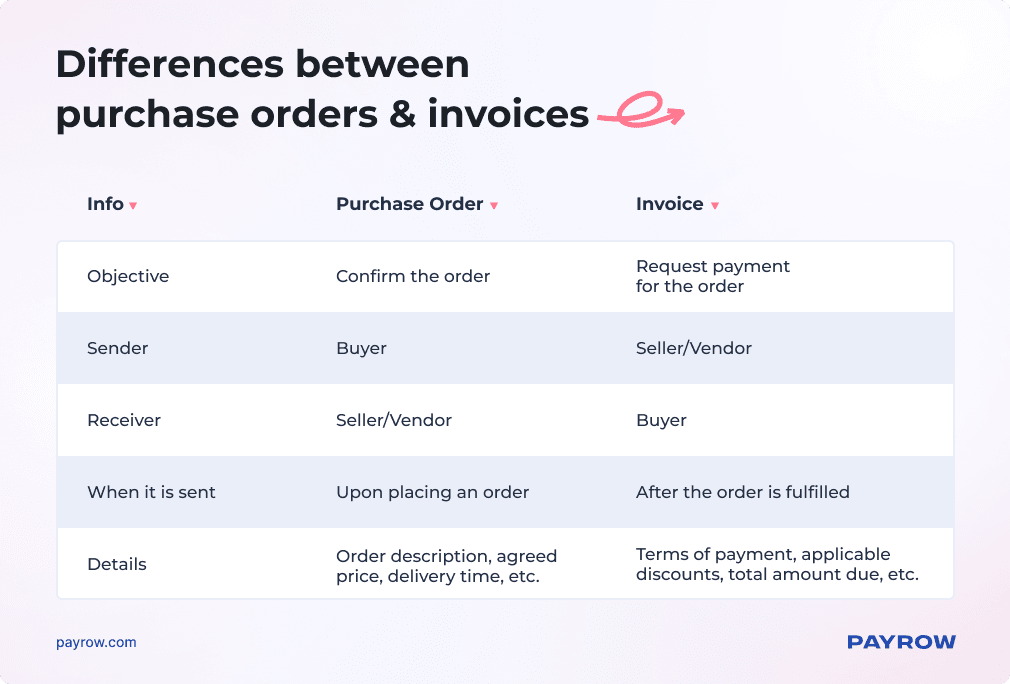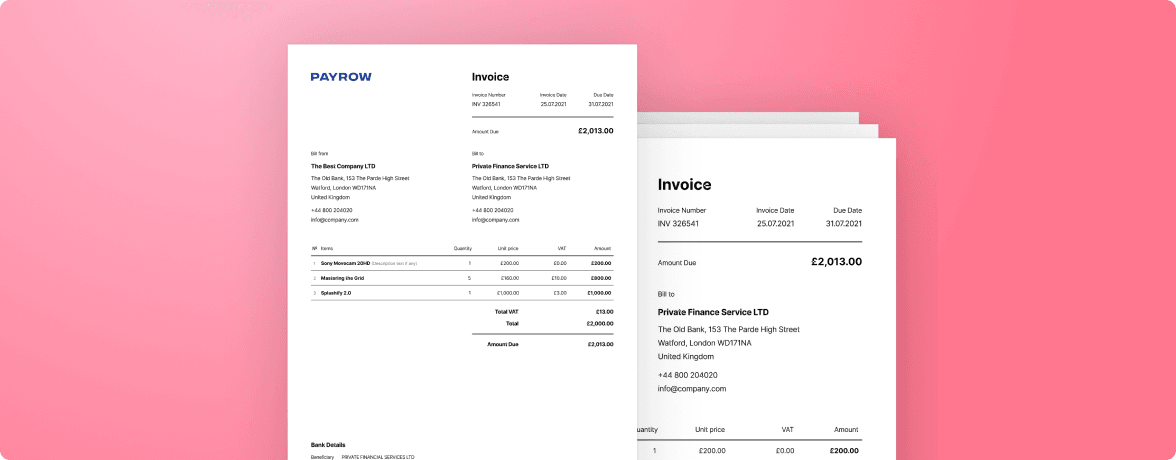• 7 MIN READ
Purchase Order vs Invoice: Similarities and Differences
April 19, 2024

Managing purchase invoices and orders is commonly part of financial business activity documentation processes. Filling in and saving these essential documents with data about your business transactions is necessary for compliance and organisation of financial records.
Purchase orders and invoices serve distinct purposes while sharing some similarities. In this article, we’ll explain their features and their value for businesses. You’ll learn how to issue purchase orders and invoices in the UK and how modern digital services help do this automatically to save you time and effort.
Read also: Revenue vs Turnover in the UK: Breaking Down the Basics
What Is a Purchase Order?
Purchase orders are documents that detail the intention of a buyer to purchase goods from a supplier, specifying the items, quantity, price, and other terms of the purchase. A purchase order (PO) is issued by the buyer to the vendor and outlines their expectations. Sometimes, POs also include pre-conditions that the buyer and seller agree on before the purchase. This could be, for example, the use of an alternative payment method for the order.
Purchase orders serve as legally binding contracts between the buyer and the supplier that provide a clear record of agreed-upon purchases. They help maintain accuracy, ensure legal accountability, and enhance financial management. There are different types of POs; for example, buyers can use standing purchase orders for recurring purchase facilitation or blanket purchase agreements for multiple deliveries for a set price over a certain period.
There’s a concept that sounds similar to a PO but means a different thing. Let’s compare purchase requisition vs. purchase order. Employees at large companies use purchase requisitions to place orders with the purchasing department. The department then buys the required items from an outside supplier or vendor. Thus, the order is processed internally by employees who manage the procurement process. Purchase requisitions are common in large-scale enterprises with an accounting or finance department but are rarely used in small and medium-sized businesses.
What Information Does a Purchase Order Contain?
A standard PO typically contains the following information:
- Date of purchase
- PO number
- Delivery date
- Product or service specifications
- Order and price details
- Discounts
- Quantity details
- Vendor and shipping information
In addition, purchase orders may contain a buyer-seller expectations outline so that both parties have a clear understanding of what is expected from the transaction. These extra details help to avoid misunderstandings and ensure a transparent deal-making process.
Why Is a Purchase Order Important?
Purchase orders are used for inventory management optimisation and financial control, enabling better budgeting. By tracking who buys what, when, and from whom, companies get a better understanding of their financial state and make more realistic budget forecasts. Purchase orders also help negotiate volume discounts with suppliers, which makes it possible for the buyer to save money while allowing the seller to sell larger quantities.
From an operational perspective, purchase orders simplify the procurement process. They improve monitoring, cost management, and internal inventory controls. They also promote accountability and reduce the risk of financial and operational errors. Moreover, POs serve as a useful reference for audits, reconciliation with suppliers, and maintaining relationships between organisations. They may also come in handy during dispute resolution.
What Is a Purchase Order Number?
A purchase order number is a unique identifier assigned to a purchase order. This number helps both vendors and buyers track and reference the orders they’ve sent or received. They make it significantly easier to maintain and organise purchase order records. A PO number is usually placed at the top of invoices for easy identification and reference.
Small companies may be able to manually assign purchase order/invoice numbers for each new transaction. However, large companies deal with a much higher volume of transactions, so entering purchase order numbers manually is time-consuming. Most cloud accounting solutions automatically generate relevant purchase order information, including assigning unique numbers to individual purchase orders.
What Is an Invoice?
An invoice is a document that confirms the shipment of goods to a customer or the provision of services and indicates the value of the products. A seller issues an invoice to the customers when requesting payment for goods provided or services rendered. This document is presented to the buyer either before or after the transaction and establishes an obligation for the buyer to pay.
Purchase invoices are legally binding agreements between the seller and buyer and cannot be ignored or removed from trading records in terms of accounting. So, every purchase invoice should be well-documented. If your company is VAT (Value Added Tax) registered, invoices must be prepared following HMRC VAT rules.
What Information Does an Invoice Contain?
A standard invoice typically contains the following data:
- Dates: the date the goods or service were provided and the date of the invoice.
- A unique identification number that you must assign to each invoice.
- Your business name, address, and contact information. For an LLP — it’s your registration number and address; for the self-employed —it’s your first and last name and the business name under which you operate.
- Your customer’s company name, contact information, and address. It may be beneficial to identify other individuals as well.
- Description of what you charge for: names of items or services, quantity/time, price/hourly rate.
- The total amount being charged and the VAT amount, if applicable.
- Financial terms and payment options, as well as the specific payment due date.
Why Are Invoices Important?
Invoices are important both for fulfilling fiscal and tax obligations and for controlling and managing capital. They are part of the most common cash flow maintenance strategies. Invoices are essential for declaring income, especially for the self-employed. They provide a thorough record of all income and sales, which is essential for tax reporting purposes, and help companies keep track of incoming and outgoing payments, allowing for better financial planning.
Additionally, invoices serve as legal documentation of a transaction, providing evidence of the provision of goods or services and agreed payment terms. By tracking invoices, businesses make better decisions when it comes to future operations, determining which projects are most profitable and which should be discontinued.
Differences Between Purchase Orders and Invoices
Purchase orders and invoices commonly serve for transaction type identification: purchases vs. sales. Therefore, they have clear differences. Firstly, the purpose is different: purchase orders show the intention of the buyer to buy your product or order a service, while invoices request payment for the goods or services provided. Secondly, the issuer is different: POs are issued by the buyer, while invoices are issued by the seller.
Thirdly, these documents contain slightly different data: POs detail the description of the order, the agreed price and quantity, and the expected delivery date, whereas invoices detail the total amount due and the date of payment in addition to the information specified in the purchase order.
Finally, purchase orders and invoices are sent at different times: POs are sent at the beginning of the ordering process to establish the buyer’s intentions, while invoices are usually sent at the end (after the goods and services have been provided) to request payment.

Still, there are similarities between a purchase order and an invoice:
- Both documents are crucial in the procurement process and represent commercial messages about goods and services.
- Both of them provide better visibility of the deal-making process and include basic order details, delivery information, buyer and supplier details, and prices.
- Once sent and received, both documents are legally binding agreements requiring the services or products to be prepared and paid for according to the agreed terms and conditions.
Why Do Businesses Need Both Purchase Orders and Invoices?
Purchase orders help initiate and manage orders by providing clear instructions on the goods or services required, their quantities, and delivery details. They help track orders, ensure fulfilment, and manage contractual relationships.
In contrast to that, invoices are required to receive payment for goods or services provided. They contain details about goods, total payment amounts, due dates, and payment options. Invoices ensure payment accuracy and are important for cash flow management.
The combined use of purchase orders and invoices allows companies to effectively manage sales, track income, forecast cash flow needs, and maintain solid relationships with their vendors and customers. Purchase orders and invoices provide clarity, security, and efficiency to the procurement process, allowing businesses to operate smoothly.
Issuing Invoices Digitally
There are hardly any companies left that send invoices in paper form. Some banks and FinTech companies offer a valid alternative — paperless services for document management. For example, you can easily send an invoice through Payrow.
To send an invoice to a customer:
- Click the “Invoices” tab on the main menu of your Payrow Business account.
- Click the “New Invoice” button at the top of the screen.
- Add or select the desired customer.
- Select the appropriate currency.
- Add the product(s) to which the invoice is related and click “Continue”.
You can send invoices in the following currencies: GBP and EUR.
Create and Send Invoices on the Go with Payrow Services

At Payrow, we offer invoice automation services that simplify order and money management for hundreds of small and medium-sized businesses across the UK. Automation of your invoices brings several benefits:
- Automated invoice processing leaves no room for human error or typographical mistakes during data entry. Invoice data is automatically collected and checked for accuracy.
- Having access to all invoices in one convenient place reduces time spent searching for specific documents and increases productivity.
- With invoice automation software, documents are mechanically loaded into the system, allowing companies to accept payments much faster.
- A quick snapshot of all upcoming payments at any given time provides you with control over payment due dates and improves your ability to budget for the future.
- The timely payment of vendors is ensured via alerts and notifications sent to relevant parties.
Control outgoing and incoming payments with free invoicing software by Payrow!
FAQ
What Are the Steps for Issuing Purchase Orders and Invoices?
You can use money management software to generate both types of documents. To issue a PO, state the need for goods or services and include details such as company names, the date, PO number, description, quantity, price, and other comments. For invoicing, include the relevant dates, unique identification number, names of companies involved, goods or services sold, total amount due, and terms of payment.
What Role Does a Purchase Order (PO) Number Play in Business Transactions?
Order numbers are important in business transactions because, when included in documents, they help maintain a clear link between the purchase order and the actual order fulfilled, ensuring accurate record-keeping and payment allocation. Having a PO number ensures sales control and transparency. This practice is necessary for both buyers and suppliers to avoid mistakes.
What Essential Information Must an Invoice Contain to Ensure Accuracy?
A standard invoice usually contains dates, a unique identification number, the names, addresses, and contact details of your company and your client, a description of the goods or services provided, and their quantity and price. Calculate and state the total amount payable and the amount of VAT, if applicable. Indicate the specific date of payment.